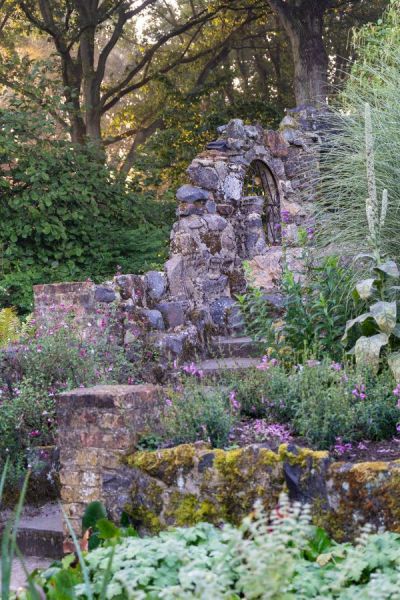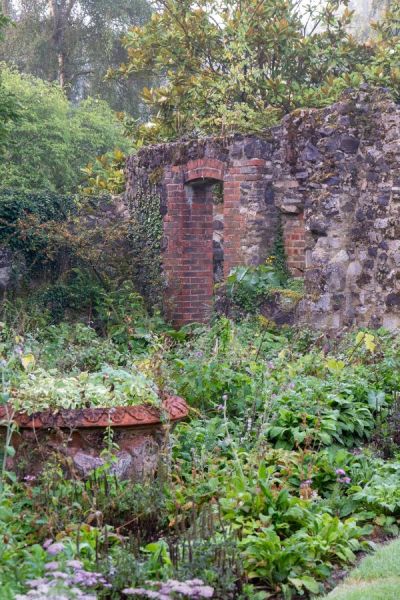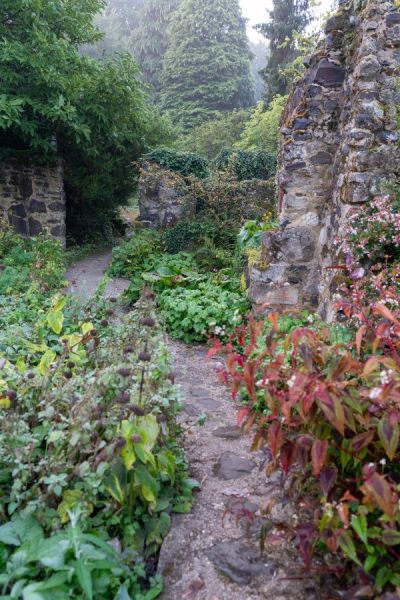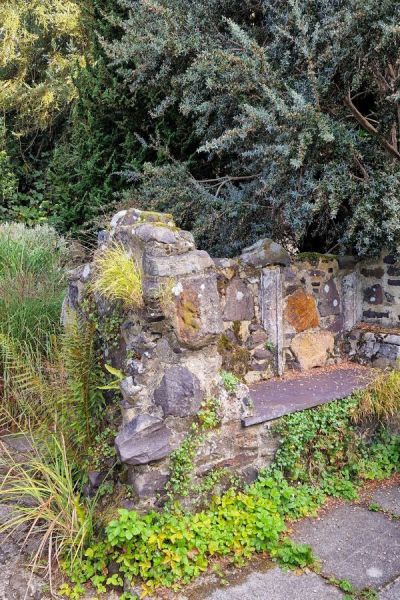Garden ruins and follies add more to your garden than you think!
If you look up garden ruins or follies in the dictionary, you will be told that they are ‘costly ornamental buildings with no practical purpose.’
However, the dictionary clearly wasn’t written by gardeners. Garden ruins and follies have several practical uses in your garden.
They can be a focal point. They may be used to divide up the space in a garden.
And, according to William Dyson, curator of Great Comp Garden in Kent, they can create a ‘micro-climate’ for growing different plants.
Ruins and follies also add height to your garden, he says. You can grow climbers up them or use them to display plants.
And they can help protect tender plants from the prevailing wind.
You could even turn your garden shed into a folly. You could still use it as a garden shed, as Roger Lloyd did in an evergreen garden with a touch of grandeur.
And on top of all that, garden ruins and follies add drama and fantasy to your outdoor space.

Many visitors mistake the ‘Old Ruins’ at Great Comp Garden for the remains of a monastery – but they were built in the 1980s by Eric Cameron. Eric and Joy Cameron created Great Comp Garden in the latter half of the 20th century. When digging to create borders, Eric found a huge amount of Kentish ragstone and flint, so he created the ‘Ruins’ to use them up.
Garden ruins and follies don’t have to be expensive
Follies are part of the design language of the great historic French and English gardens, with their Classical or Gothic temples, pavilions and ‘ruins’.
But they don’t have to be expensive.
Great Comp Garden is famous for its follies and garden ruins. They make the garden feel magical and mysterious, but they were created in the last half of 20th century by Eric Cameron.
When he dug out the borders at Great Comp, he had to remove a huge amount of Kentish ragstone and flint. So he created the ‘ruins’ to use up the materials. He also kept a sharp eye out for salvaged materials and ‘job lots’ he picked up as bargains. He even did most of the work himself.
So I asked William Dyson about what garden ruins and follies could do for our own gardens.

‘The Tower’ at Great Comp Garden was built by Eric Cameron in the late 1980s. He created the height by piling up discarded motorbikes, washing machines, TVs and other things that were being thrown away, then covering them in concrete. ‘There’s a small municipal tip under the Tower’ says William Dyson. ‘He used discarded items so he didn’t have to use so much concrete.’
Use architectural salvage and buy seconds
Great Comp is a lesson on using what you’ve got and re-using anything you can buy cheaply. Eric Cameron was proud of being Scottish and thrifty, and he did much of the work himself.
The Italian Garden at Great Comp is effectively a small walled garden within the main garden. So it is more sheltered and the walls retain the sun’s heat.
Eric Cameron was offered a’ job lot’ of bricks by a builder. He also went to Chilstone, which makes reconstituted stone garden ornaments and architectural stone. ‘There were ‘seconds’ lying around in the yard,’ says William. And because they’d been left outside, they’d already started to look nicely aged.
They also continued to use the flint stones they’d dug up from the borders.
Also look in architectural salvage yards and on exchange sites, such as Facebook Marketplace or Freegle.

Eric Cameron was offered a cheap ‘job lot’ of bricks which he used to create The Italian Garden in the early 1990s (top photo). The two walls create a sheltered micro-climate so they can grow tender plants, such as tetrapanax and dahlias in it.
How garden ruins and follies affect plants
William explained that a garden ruin or folly can create a micro-climate so that you can grow specific plants.
At its simplest this means that a wall (it will probably be a crumbling or broken wall!) has two sides. If you position it from East to West, you create a south-facing side and a north-facing one.
The south facing side will get the sun, which will heat the brick or stone. The brick or stone then gives off that heat at night. So you’ll create an area that is just a little warmer and more sheltered than the more open areas of your garden.
On the other side of the wall, it will be shady and cool. That will be perfect for ferns or epimediums, says William.
And you position your wall to shield the plants from the prevailing wind, too.

The ‘Old Ruins’ at Great Comp are a series of apparently crumbling ragstone walls with the remains of doors and windows. One side is sheltered, dry and sunny and the other side is shady, giving William more planting options. And instead of an open space, the walls and planting stop the wind.
Divide up space or add height
Great Comp Garden was originally fairly open and flat. Now a myriad of paths entice you into the planting, with walls and doorways leading you on a magical journey. At every turn you come across a ruined cottage…or is it a ruined castle?
Occasionally, you look down, to see what appears to be fragments of an old floor.

Many people mistake the Old Ruins at Great Comp for the remains of a monastery. In fact, Eric Cameron added them to use up garden flints and to create windbreaks and break up garden space.
Garden ruins as a focal point
You could choose a spire, a tower or a temple. Or you can add a statue or an urn to a wall or archway.
Bill and Lynda Rudgard saw a Gothic window in a salvage yard and bought it immediately. It was one of a set of windows from a demolished church in Halifax. They shipped it down to their home in Kent, and had it set in flint and stone. They’ve sited it at the end of their garden overlooking farmland, adding some upright stones and pavers in the ground to give the impression that this is all that remains of an old church.

Bill and Lynda Rudgard bought this old church window from an architectural salvage yard to make a focal point at the end of the garden.

This thoughtful statue complements the ‘crumbling’ walls at Great Comp and acts as a focal point at the end of a path.
Use garden ruins as seating or raised beds

You can incorporate seating or raised beds into crumbling walls and garden ruins, like this bench of flint and slate at Great Comp.
You may already have some ‘ruins’
If you’ve had a major renovation in your home, you’ll know how fascinating fragments of old paint and paper are.
There was a collapsing conservatory in Mark Walker’s Victorian house. It wasn’t practical to restore it or to replace it with another room. So Mark has turned it into a terrace in the garden, letting the marks of the previous layers to be exposed to the elements. (You can see how he’s turned a shady town garden into a contemporary outdoor space without losing any of its character here.)
And one of the most magical gardens at RHS Chelsea 2023 was Cleve West’s garden around the walls of a ruined house. It had quite a similar feel to Mark’s back garden.

Leaving walls undecorated to show the layers of paint and past decoration is a contemporary take on ‘garden ruins’. The top photo is Mark Walker’s small town garden in Margate and the photo above shows Cleve West’s show garden for Centrepoint at RHS Chelsea 2023
Where to position garden ruins and follies
William says that when you’re thinking about creating garden ruins or follies, you should ‘consult the genius of the place’.
That means thinking about the architecture and surroundings. Do you want to be in harmony with a particular architectural style? Or do you want a contrast?
Is your folly going to be purely ornamental? Or do you want to use it to display or grow plants on? If so, think about where the sun falls and how the prevailing wind blows.
And think about what it will look like from every angle, including what neighbours or passers-by may see. Also think about what you will see when you’re sitting in or on your garden ruins, if they’ve got a seat.

The Temple at Great Comp creates a vista – there is a long path the width of the garden with the Temple at its end as a focal point. And when you’re in the Temple, you can see right across the garden, although the trees have now grown over most of the view.
Do you need planning permission for follies and garden ruins?
This very much depends on where you live. In most places, you won’t need planning permission if your folly or garden ruin is no higher than a garden shed.
But new developments, listed buildings and some other areas may have tight planning restrictions, so check your local regulations. If you can’t find anything specifically relating to follies, then look at what is allowed in terms of garden sheds, tennis courts or other garden structures.
Visiting Great Comp Garden
Great Comp is open from 10am-5pm from 1st March to 31st October.
There are also events, such as the Bulbs N Things Autumn Fair on October 15th. You’ll find top bulb suppliers, plus a selected group of unusual garden-related stalls.
The garden is also open for special events and workshops and can also be hired for weddings.
It’s the home of Dyson’s Salvias, the UK’s leading salvia nursery. Salvias are increasingly popular in the UK as they flower for exceptionally long periods. See William’s advice on salvias here.

Great Comp in Kent has 7 acres of garden, with exceptional salvias, grasses, herbaceous borders and ‘garden ruins.’ Don’t miss the autumn Bulbs Fair on October 15th.
See Great Comp’s garden ruins and follies in video
You can get a really good idea of what Great Comp’s garden ruins and follies look like in this video, along with more views of the other gardens shown.

Pin to remember garden ruins and follies
And do join us. See here for a free weekly email with more gardening tips, ideas and inspiration.

























Thank you again for an interesting and inspirational message. I live across the world from you – but in a similar gardening climate. In Port Angeles WA, USA, I am directly across the Straits from Victoria,B.C. in a moderate climate that is very wet in the winter and dry in the summer. My only complaint is an on-going battle with Horsetail. I’m hoping you might have a solution that doesn’t involve selling the property and moving???
Oh, dear, that is a problem! Have you tried the no-dig method of covering it up and depriving it of light? It does, however, mean having your garden or part of your garden covered with black horticultural plastic or similar for months on end. The RHS says that shallow weeding can make the problem worse because little bits of roots get left in the ground and multiply, but that regularly removing the shoots above the ground (ie with mowing) can eventually weaken them. You have my sympathy, and I have much the same with bindweed.